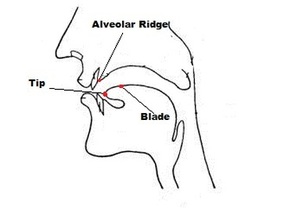Vowel Awareness | Oral Vowel Tuning | Consonants | Nasal Vowels | Phonetic Notation Key
Consonants
In contrast to vowel sounds, which are made by completely opening the vocal tract, consonant sounds are created by momentarily blocking the vocal tract while expelling air. Once again, you must learn to distinguish consonant sounds from consonant letters. Portuguese uses the same letters as English, but the corresponding sounds can be completely different. Also, letters are pronounced differently across dialects, even within the same country.
Therefore, it is extremely important for you to stop thinking about speech sounds in terms of letters. If you can separate the two, you will be able to easily distinguish the differences in accents and acclimate your ear to new dialects. Your ability to think of Portuguese purely in terms of the sound will improve as you learn more songs.
Once again, each of the letters used below will ALWAYS represent the sound assigned to them. This is completely independent of either the Portuguese or English writing systems.
Therefore, it is extremely important for you to stop thinking about speech sounds in terms of letters. If you can separate the two, you will be able to easily distinguish the differences in accents and acclimate your ear to new dialects. Your ability to think of Portuguese purely in terms of the sound will improve as you learn more songs.
Once again, each of the letters used below will ALWAYS represent the sound assigned to them. This is completely independent of either the Portuguese or English writing systems.
Denti-Alveolar /d̪/ and /t̪/
|
|
This may seem like an unimportant detail, but it is EXTREMELY important to build a habit of dentalizing your "d" and "t", because certain Portuguese sound combinations are IMPOSSIBLE to produce with the English, tip-of-the-tongue, /d/ and /t/.
Alveolar Tap /&/
|
|
"Throaty" /ʁ/
In general, know that there is more than one way to make this sound, and the same person will say it different ways depending on the context. When listening to and MImicking Portuguese speakers, try to open your ears up to the different nuances. |
|
/ʒ/
|
|
And that's it! As different as Portuguese sounds are from English, there are very few differences in their consonants. Some of you may trip up with the alveolar tap /&/, but the rest of the sounds should not be difficult. The trick is learning to create these consonants sounds in combinations that don't exist in English, and this is why we have the song training.
Your biggest challenge in learning the Flow of Portuguese will lie with the nasal vowels. This is what we will look at in the next section - Nasal Vowels.
Your biggest challenge in learning the Flow of Portuguese will lie with the nasal vowels. This is what we will look at in the next section - Nasal Vowels.


